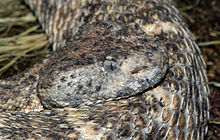- Crotalus mitchellii stephensi
-
Crotalus mitchellii stephensi 
Scientific classification Kingdom: Animalia Phylum: Chordata Subphylum: Vertebrata Class: Reptilia Order: Squamata Suborder: Serpentes Family: Viperidae Subfamily: Crotalinae Genus: Crotalus Species: C. mitchellii Subspecies: C. m. stephensi Trinomial name Crotalus mitchellii stephensi
Klauber, 1930Synonyms - Crotalus confluentus stephensi - Klauber, 1930
- Crotalus mitchellii stephensi - Klauber, 1936
- Crotalus mitchellii stephensi - Schmidt, 1953
- Crotalus mitchellii stephensi - McCrystal & McCoid, 1986[1]
Crotalus mitchellii stephensi is a venomous pitviper subspecies[3] found in southern Nevada and adjacent California.[4]
Contents
Description
Adults are 58-132 cm in length, with an average of 60-91 cm.[5]
According to Klauber (1936), this subspecies is characterized by the absence of the vertical light line on the posterior edge of the prenasals and first supralabials. The supraocular scales are pitted, sutured or with the outer edges broken.[2]
The color pattern consists of a straw, tan, buff, brown or gray ground color, overlaid with a series of buff, gray, brown or deep red-brown blotches. Often, there are gray suffusions on the sides of the body and head, and a scattering of black-tipped scales on the back, especially at the edges of the blotches.[2]
Common names
Panamint rattlesnake, panamint rattler, Owens Valley rattler, tiger rattlesnake.[2]
Geographic range
Occurs in desert-mountain areas of eastern slopes of the Sierra Nevada from Mono County, California, east to Nye County, Nevada, south through southwestern Nevada, southeast to Clark County, Nevada, and southwest to central San Bernardino County, California. Found at 900-2400 m altitude.[2]
Feeding
The diet consists of small mammals, lizards, and birds.[5]
Reproduction
These snakes are viviparous and the young are born in July and August. Neonates are about 25 cm in length.[5]
See also
- List of crotaline species and subspecies
- Crotalus by common name
- Crotalus by taxonomic synonyms
- Crotalinae by common name
- Crotalinae by taxonomic synonyms
- Snakebite
References
- ^ McDiarmid RW, Campbell JA, Touré T. 1999. Snake Species of the World: A Taxonomic and Geographic Reference, vol. 1. Herpetologists' League. 511 pp. ISBN 1-893777-00-6 (series). ISBN 1-893777-01-4 (volume).
- ^ a b c d e Wright AH, Wright AA. 1957. Handbook of Snakes. Comstock Publishing Associates. (7th printing, 1985). 1105 pp. ISBN 0-8014-0463-0.
- ^ "Crotalus mitchellii stephensi". Integrated Taxonomic Information System. http://www.itis.gov/servlet/SingleRpt/SingleRpt?search_topic=TSN&search_value=209527. Retrieved 5 November 2006.
- ^ Behler JL, King FW. 1979. The Audubon Society Field Guide to North American Reptiles and Amphibians. New York: Alfred A. Knopf. 743 pp. LCCCN 79-2217. ISBN 0-394-50824-6.
- ^ a b c Crotalus mitchellii stephensi at Californiaherps.com. Accessed 5 November 2006.
External links
- Crotalus mitchelli at the Reptarium.cz Reptile Database. Accessed 12 December 2007.
Categories:- Crotalus
- Reptiles of the United States
- Fauna of the Western United States
Wikimedia Foundation. 2010.
